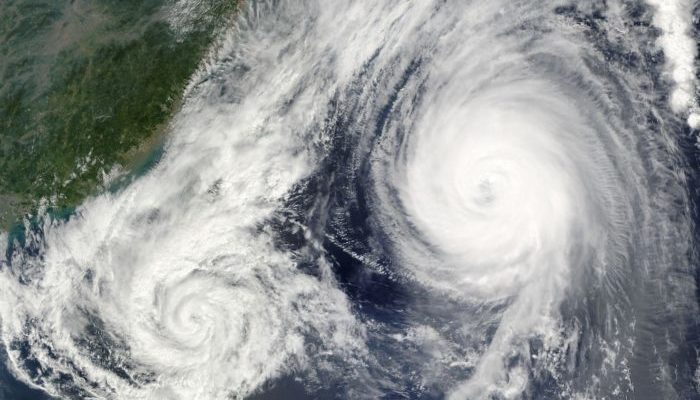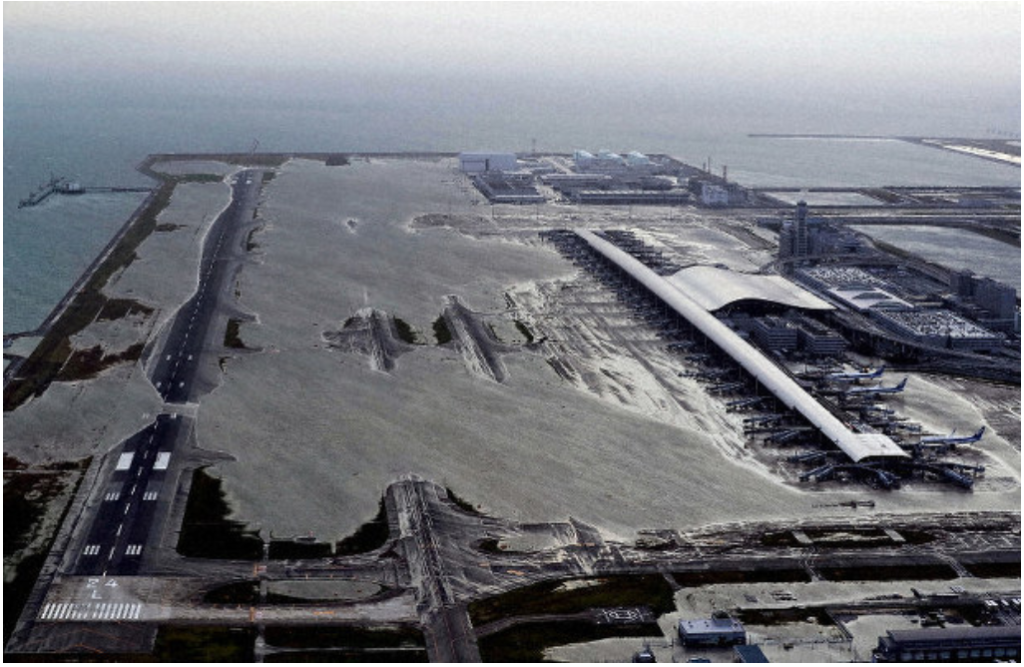
When you read about climate extremes, what is the first thing that comes to your mind? Probably not airport systems. However, you might have been affected at least once by delays, longer flights, or even flight cancellations due to low visibility, strong winds, convective activity which can lead to thunderstorms. Especially, if you reside in or have flown to or from the United Kingdom, the Netherlands, the United States, Caribbean Islands, Hong Kong or Japan.
Climate extremes refer to the occurrence of patterns of unexpected or severe extreme weather or climate (e.g. hurricanes, heavy daily or monthly rainfall, snowstorms, heat waves, drought) that are often rare at a particular place and time of year. The Intergovernmental Panel for Climate Change (IPCC) defines climate extremes as “the occurrence of a value of a weather or climate variable above (or below) a threshold value near the upper (or lower) ends of the range of observed values of the variable”. Climate extremes can be a result of natural climate variability; however, there is evidence that human-induced global warming is increasing the frequency and intensity of some occurrences (e.g. extreme precipitation, drought) [1].
Climate extremes refer to the occurrence of patterns of unexpected or severe extreme weather or climate (e.g. hurricanes, heavy daily or monthly rainfall, snowstorms, heat waves, drought) that are often rare at a particular place and time of year.
The major risks the world will face in the future
I was recently reading the Global Risks Report 2020, published by the World Economic Forum [2], which is a document that presents the major risks the world will be facing in the coming year, based on assessments by several major insurance and reinsurance companies, focused workshops, interviews and surveys. I was not surprised to see that extreme weather, climate action failure, and natural disasters are listed as top risks in terms of impact and likelihood. There seems to be a general agreement that one of the main concerns of climate change is the increase in the occurrence or the intensity of extreme weather events that can impact the human and the natural environment [3].
Over the past years, climate extremes have caused widespread damage and alterations to the normal functioning of almost all human-made systems, raising various concerns. These concerns also apply to airport systems, which, like many other types of critical infrastructures, seem to demonstrate high sensitivity to climate extremes. And to see how sensitive airports can become all you have to do is look at the latest news about Storm Ciara (also known as Storm Sabine in parts of Europe, Ed.) and the widespread disruption throughout Britain, including the cancellation of hundreds of flights [4]. And why is this important to address? Because the impact can be more significant than a couple of hours of travel disruption, especially if you consider the overall function of airports and the role of air transport [5].
extreme weather, climate action failure, and natural disasters are listed as top risks in terms of impact and likelihood
Climate extremes and airport systems
Climate extremes can disrupt air travel, damage airport infrastructure and supporting systems, or even cause airport closures impacting safety and business operations. Disruptions leading to cancellations or delays of flights may also have an impact on the performance of the service providers, which may be associated with the perception of a low-value service with a negative impact on the airport or the airline business or may lead to negative socio-economic effects and changes in travel behaviour [6].
The most apparent impact relates to airport infrastructure. Infrastructure is costly to build, and it is designed to last for decades, making the replacement difficult and expensive. Climate extremes, like frequent heavy precipitation, may, for example, stress airport drainage systems causing flooding and damage. Also, in the case of airports located by the coastline hurricanes may lead to inundation of runways, airfield areas, access roads, and other airport facilities [7, 8].
Even when there is no physical damage, the provision of the service can be affected due to poor weather conditions or climate extremes. In the United States in 2015, as a result of a snowstorm, in a day, more than 4700 flights were delayed, and nearly 3900 flights were cancelled [9]. Looking at the air transport delay analysis in Europe in the past five years (January 2015 to December 2019) weather-related delays seem to represent 8.2% of the total delays (e.g. airline, airport, en-route, government, etc.). In some of the larger airports, like London Heathrow, London Gatwick, Amsterdam Schiphol Airport and Frankfurt Airport weather-related delays mainly relate to convective weather, low visibility, and strong winds [10].

Figure 1: Primary departure delay causes for January 2015 – December 2019
(Image credit: Eurocontrol CODA [10])

Figure 2: Kansai International Airport in Osaka Prefecture (Western Japan) after Typhoon Jebi
(Image credit: Mainichi Shimbun [13])
What can be done to address climate extremes and their impact?
At an international level, the key question is, how should an airport infrastructure be designed to be more climate-resilient? The International Civil Aviation Organisation (ICAO) recognises that the global aviation community needs to find efficient and effective ways to deal with any impact attributable to a changing climate while at the same time reducing the environmental impact of air transport. However, the implications of climate change on aviation have only recently begun to emerge and to be studied. As a result, even though the global sector has already considered adaptation plans not many measures are in place and, in many cases, they do not seem adequate to cope with the extremes. Consequently, many airports remain vulnerable to climate extremes and must deal with disruption to services and ground access, as well as high maintenance costs.
problems can also be perceived as opportunities for future airport infrastructure development to improve climate resilience
Nevertheless, problems can also be perceived as opportunities for future airport infrastructure development to improve climate resilience. Many airport operators have already begun assessing their vulnerability to climate extremes focusing on the identification of the components of the infrastructure with an increased risk of failure, damage, deterioration, or reduced operational effectiveness. As early responses to climate risks can be more cost-effective, the integration of adaptation options into existing and new infrastructure development plans seems to be the way forward. There are examples of airports that are redesigning existing infrastructure to cope with climate extremes. Brisbane Airport moved forward to a detailed flood and drainage planning to set the minimum levels for all new developments to ensure the continuation of operations in the case of cyclonic events and sea-level rise. Changi Airport in Singapore designed the Changi East site at 5.5m above mean sea level to enhance the airport’s resilience against coastal erosion and inundation associated with rising sea levels and storm surges [17].
These are good examples in the case of new airports construction or in the case of airport expansion and renovation, but what will happen if there are no such plans? Maybe, in this case, the incorporation of dedicated response mechanisms in the emergency services planning, and the establishment of hazard recovery processes to safeguard operations can be options to consider. Hong Kong International Airport can be used as an example of rapid response and recovery from adverse weather. Working closely with the Hong Kong Observatory and Air Traffic Control to assess the potential impact and to prepare critical contingency measures the airport seems to be capable of resuming normal operations in an orderly manner once the climate extreme event has passed, like in the case of Typhoon Hato in 2017 [17].
The aviation sector is known to be very proactive in hazard identification as part of the safety risk management process. However, in the case of climate extremes, the response seems to be slightly different. Climate hazards are not always identified as threats. Although there is evidence highlighting the need for adaptation, it seems that the definition of the acceptable risk or the current perception of the risk drives existing action plans and the level of preparedness. This seems especially true in the case of low probability events, even if they have the potential to cause significant damage.
References
[1] IPCC, 2012: Managing the Risks of Extreme Events and Disasters to Advance Climate Change Adaptation. A Special Report of Working Groups I and II of the Intergovernmental Panel on Climate Change [Field, C.B., V. Barros, T.F. Stocker, D. Qin, D.J. Dokken, K.L. Ebi, M.D. Mastrandrea, K.J. Mach, G.-K. Plattner, S.K. Allen, M. Tignor, and P.M. Midgley (eds.)]. Cambridge University Press, Cambridge, UK, and New York, NY, USA, 582 pp.
[2] World Economic Forum: The Global Risks Report 2020 Insight Report 15th Edition, Geneva. [online] Available from: www.weforum.org (Accessed 24 January 2020), 2020.
[3] Easterling, D. R., Meehl, G. A., Parmesan, C., Changnon, S. A., Karl, T. R. and Mearns, L. O.: Climate extremes: Observations, modeling, and impacts, Science (80-. )., 289(5487), 2068–2074, doi:10.1126/science.289.5487.2068, 2000.
[4] Calder, S.: Storm Ciara: Travel chaos as hundreds of flights cancelled due to gale-force winds, INDEPENDENT, 10th February [online] Available from: https://www.independent.co.uk/travel/news-and-advice/storm-ciara-travel-flights-trains-cancelled-uk-weather-latest-british-airways-easyjet-a9325456.html, 2020.
[5] ATAG: Aviation benefits beyond borders. https://www.atag.org/component/attachments/attachments.html?id=707, 2018
[6] Eurocontrol: European Aviation in 2040 – Challenges of Growth. [online] Available from: https://www.eurocontrol.int/sites/default/files/content/documents/official-documents/reports/challenges-of-growth-2018.pdf, 2018.
[7] Lopez, A.: Vulnerability of airports on climate change: an assessment methodology, Transp. Res. Procedia, 14, 24–31, doi:10.1016/j.trpro.2016.05.037, 2016.
[8] National Academies of Sciences Engineering and Medicine: Using Existing Airport Management Systems to Manage Climate Risk, Washington DC., 2018.
[9] Chen, Z., Rose, A. Z., Prager, F. and Chatterjee, S.: Economic consequences of aviation system disruptions: A reduced-form computable general equilibrium analysis, Transp. Res. Part A Policy Pract., 95, 207–226, doi:10.1016/J.TRA.2016.09.027, 2017.
[10] Eurocontrol: Central Office for Delay Analysis (CODA), Eurocontrol Data [online] Available from: www.eurocontrol.int (Accessed 15 February 2020).
[11] Mori, N., Yasuda, T., Arikawa, T., Kataoka, T., Nakajo, S., Suzuki, K., Yamanaka, Y. and Webb, A.: 2018 Typhoon Jebi post-event survey of coastal damage in the Kansai region, Japan, Coast. Eng. J., 61(3), 278–294, doi:10.1080/21664250.2019.1619253, 2019.
[12] International Civil Aviation Organisation (ICAO): Destination Green: The Next Chapter – 2019 Environmental Report. [online] Available from: https://www.icao.int/environmental-protection/Documents/ICAO-ENV-Report2019-F1-WEB (1).pdf, 2019.
[13] Mainichi Japan: Mainichi wins record 31st top Japan newspaper award for photos taken after 2018 typhoon, [online] Available from: https://mainichi.jp/english/articles/20190904/p2a/00m/0na/013000c, 2019.
[14] Cools, M., Moons, E., Creemers, L. and Wets, G.: Changes in travel behavior in response to weather conditions. Do type of weather and trip purpose matter?, J. Transp. Res. Board, 2157, 22–28, doi:10.3141/2157-03, 2010.
[15] Dogru, T., Marchio, E. A., Bulut, U. and Suess, C.: Climate change: Vulnerability and resilience of tourism and the entire economy, Tour. Manag., 72, 292–305, doi:10.1016/J.TOURMAN.2018.12.010, 2019.
[16] Hellingrath, B., Babun, T. A., Smith, J. F. and Link, D.: Disaster Management Capacity Building at Airports and Seaports, in Humanitarian Logistics and Sustainability, edited by M. Klumpp et al. (eds.), pp. 87–112, Springer International Publishing, Switzerland., 2015.
[17] Airports Council International (ACI): Airports’ resilience and adaptation to a changing climate – Questions for airports. [online] Available from: www.aci.aero (Accessed 10 March 2019), 2018.
